 W
WThe Ada Gospels is a late eighth century or early ninth century Carolingian gospel book in the Stadtbibliothek, Trier, Germany. The manuscript contains a dedication to Charlemagne's sister Ada, from where it gets its name. The manuscript is written on vellum in Carolingian minuscule. It measures 14.5 by 9.625 inches. The Ada Gospels are one of a group of manuscript illuminations by a circle of scriptoria that represent what modern scholars call the "Ada School". Other products of the Ada School include the Soissons Gospels, Harley Golden Gospels, Godescalc Evangelistary and the Lorsch Gospels; ten manuscripts in total are usually recognised.
 W
WThe Adysh Gospels is an important early medieval Gospel Book from Georgia.
 W
WThe ms. Ambrosiano O 39 sup. – is a manuscript of the Hexapla of Origen dated to the late ninth century C.E. written in a codex form. This is a palimpsest. The manuscript is designated with the number 1098 in the list of the septuagint manuscripts as the classification of Alfred Rahlfs.
 W
WThe Anbandidi Gospel is four Gospels from the 9th century. They are currently housed in the National Archives of Georgia, fond #1446, manuscript #107. They have 192 pages, are made of parchment. The dimensions are: 317x237; Asomtavruli; ink – brown, embellished initials – in certain cases with cinnabar. The text is rewritten in some parts; the manuscript is entirely written in Asomtavruli, in two columns; upper borders are cut and the traces of upper quire pagination are lost; ruling lines and dots are very visible.
 W
WCodex Angelicus designated by Lap or 020, α 5, is a Greek uncial manuscript of the New Testament. Palaeographically it has been assigned to the 9th century. Formerly it was known as Codex Passionei.
 W
WCodex Augiensis, designated by Fp or 010, α 1029 is a 9th-century diglot uncial manuscript of the Pauline Epistles in double parallel columns of Greek and Latin on the same page.
 W
WCodex Boernerianus, designated by Gp or 012, α 1028, is a small New Testament codex, measuring 25 x 18 cm, written in one column per page, 20 lines per page. It is dated paleographically to the 9th century. The name of the codex derives from the theology professor Christian Frederick Boerner, to whom it once belonged. The manuscript is lacunose.
 W
WCodex Boreelianus, Codex Boreelianus Rheno-Trajectinus, designated by Fe or 09 in the Gregory-Aland numbering and ε 86 in von Soden numbering, is a 9th century uncial manuscript of the four Gospels in Greek. The manuscript, written on parchment, is full of lacunae, many of which arose between 1751 and 1830. The codex was named Boreelianus after Johannes Boreel (1577–1629), who brought it from the East.
 W
WBritish Library, Egerton MS 609 is a Breton Gospel Book from the late or third quarter of the ninth century. It was created in France, though the exact location is unknown. The large decorative letters which form the beginning of each Gospel are similar to the letters found in Carolingian manuscripts, but the decoration of these letters is closer to that found in insular manuscripts, such as the Book of Kells and the Lindisfarne Gospels. However, the decoration in the Breton Gospel Book is simpler and more geometric in form than that found in the Insular manuscripts. The manuscript contains the Latin text of St Jerome's letter to Pope Damasus, St. Jerome's commentary on Matthew, and the four Gospels, along with prefatory material and canon tables. This manuscript is part of the Egerton Collection in the British Library.
 W
WChludov Psalter is an illuminated marginal Psalter made in the middle of the 9th Century. It is a unique monument of Byzantine art at the time of the Iconoclasm, one of only three illuminated Byzantine Psalters to survive from the 9th century.
 W
WCodex Athous Dionysiou, designated by Ω or 045, ε 61, is a Greek uncial manuscript of the New Testament. The codex is dated palaeographically to the 9th century. It has marginalia.
 W
WThe Codex Aureus of Lorsch or Lorsch Gospels is an illuminated Gospel Book written in latin between 778 and 820, roughly coinciding with the period of Charlemagne's rule over the Frankish Empire. Both the manuscript and the carved ivory panels from the cover are rare and important survivals from the art of this period.
 W
WThe Codex Aureus of St. Emmeram is a 9th-century illuminated Gospel Book. It is named after Emmeram of Regensburg and lavishly illuminated. The cover of the codex is decorated with gems and relief figures in gold, and can be precisely dated to 870, and is an important example of Carolingian art, as well of one of very few surviving treasure bindings of this date. The upper cover of the Lindau Gospels is probably a product of the same workshop, though there are differences of style. This workshop is associated with the Holy Roman Emperor Charles II, and often called his "Palace School". Its location remains uncertain and much discussed, but Saint-Denis Abbey outside Paris is one leading possibility. The Arnulf Ciborium, now in the Munich Residenz, is the third major work in the group, along with the frame of an antique serpentine dish in the Louvre. Recent scholars tend to group the Lindau Gospels and the Arnulf Ciborium in closer relation to each other than the Codex Aureus to either.
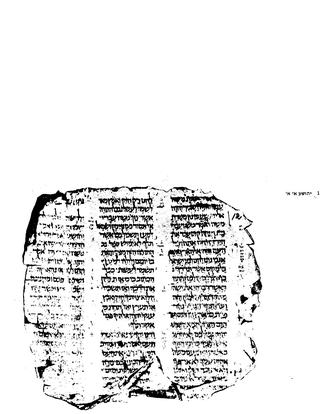 W
WThe Codex Cairensis is a Hebrew manuscript containing the complete text of the Hebrew Bible's Nevi'im (Prophets). It has traditionally been described as "the oldest dated Hebrew Codex of the Bible which has come down to us", but modern research seems to indicate an 11th-century date rather than the 895 CE date written into its colophon. It contains the books of the Former Prophets and Latter Prophets. It comprises 575 pages including 13 carpet pages.
 W
WCodex Campianus is designated as "M" or "021" in the Gregory-Aland cataloging system and as "ε 72" in the Von Soden system. It is a Greek uncial manuscript of the New Testament, dated palaeographically to the 9th century. The manuscript has complex contents. It has marginalia and was prepared for liturgical (religious) use.
 W
WCodex Cyprius, designated by Ke or 017, ε 71, is a Greek uncial manuscript of the four Gospels, on parchment. It was variously dated in the past, currently it is dated to the 9th century. It was brought from Cyprus to Paris. Sometimes it was called Codex Colbertinus 5149. The words are written continuously without any separation, with stichometrical points.
 W
WThe Ebbo Gospels is an early Carolingian illuminated Gospel book known for an unusual, energetic style of illustration. The book was produced in the ninth century at the Benedictine Abbaye Saint-Pierre d’Hautvillers.
 W
WThe Egmond Gospels is a 9th-century Gospel Book written in Latin and accompanied by illustrations. It is named after the Egmond Abbey, to which it was given by Dirk II, and where it remained for six centuries. It is most famous for being the earliest surviving manuscript showing scenes with Dutch people and buildings, and represents one of the oldest surviving Christian art treasures from the Netherlands. The manuscript has been owned by the Royal Library of the Netherlands since 1830.
 W
WThe First Bible of Charles the Bald, also known as the Vivian Bible, is a Carolingian-era Bible commissioned by Count Vivian of Tours in 845, the lay abbot of Saint-Martin de Tours, and presented to Charles the Bald in 846 on a visit to the church, as shown in the presentation miniature at the end of the book. It is 495 mm by 345 mm and has 423 vellum folia.
 W
WEgerton MS 768, British Library, London is an illuminated Gospel Book in Latin produced in Northern France during the mid-9th century. It contains the Gospels of Luke and John. The manuscript 's decoration includes lavish two page incipits which are decorated with interlace patterns for each Gospel. It was purchased by the British Library by means of the Egerton Fund established by Francis Henry Egerton, 8th Earl of Bridgewater and forms part of the Egerton Collection.
 W
WThe Codex Koridethi, also named Codex Coridethianus, designated by Θ, 038, or Theta, ε 050 (Soden), is a 9th-century manuscript of the four Gospels. It is written in Greek with uncial script in two columns per page, in 25 lines per page. There are gaps in the text: Matthew 1:1–9, 1:21–4:4, and 4:17–5:4 are missing.
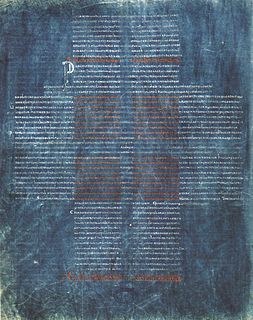 W
WThe La Cava Bible or Codex Cavensis is a 9th-century Latin illuminated Bible, which was produced in Spain, probably in the Kingdom of Asturias during the reign of Alfonso II. The manuscript is preserved at the abbey of La Trinità della Cava, near Cava de' Tirreni in Campania, Italy, and contains 330 vellum folios which measure 320 by 260 mm.
 W
WLectionary 152, designated by siglum ℓ 152 is a Greek manuscript of the New Testament, on parchment leaves. Paleographically it has been assigned to the 9th century.
 W
WCodex Macedoniensis or Macedonianus designated by Y or 034, ε 073, is a Greek uncial manuscript of the Gospels, dated palaeographically to the 9th century. The manuscript is lacunose.
 W
WMinuscule 33, δ 48 (Soden), before the French Revolution was called Codex Colbertinus 2844. It is a Greek minuscule manuscript of the New Testament on parchment, dated palaeographically to the 9th century. The manuscript is lacunose. It has marginalia. According to the textual critics it is one of the best minuscule manuscripts of the New Testament.
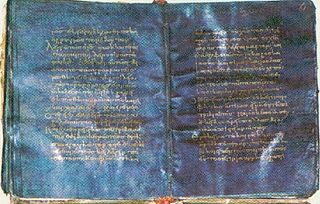 W
WMinuscule 565, ε 93 (Soden), also known as the Empress Theodora's Codex, is a Greek minuscule manuscript of the New Testament, written on purple parchment, dated palaeographically to the 9th century. It was labelled by Scrivener as 473. The manuscript is lacunose. It has marginalia.
 W
WMinuscule 1143, ε 1035, also known as the Beratinus 2, or Codex Aureus Anthimi. It is a Greek minuscule manuscript of the New Testament on purple parchment, dated paleographically to the 9th century. This is one of the seven “purple codices” in the world to have survived to the present day, and one of the two known purple minuscules written with a gold ink.
 W
WMinuscule 1424, δ 30 is a Greek minuscule manuscript of the New Testament, written on 337 parchment leaves. It has been dated paleographically to the 9th or 10th century).
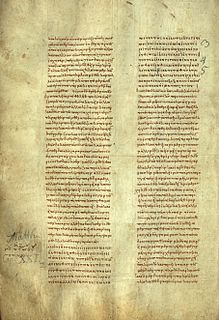 W
WCodex Monacensis designated by X or 033 (in the Gregory-Aland numbering), A3 (von Soden), is a Greek uncial manuscript of the Gospels, dated palaeographically to the 9th or 10th century. The manuscript is lacunose.
 W
WCodex Mosquensis I designated by Kap or 018, Απρ1 (Soden), is a Greek uncial manuscript of New Testament, palaeographically it has been assigned to the 9th century. The manuscript is lacunose.
 W
WCodex Mosquensis II designated by V or 031, ε 75, is a Greek uncial manuscript of the Gospels, dated palaeographically to the 9th-century. The manuscript is lacunose.
 W
WCodex Mutinensis designated by Ha or 014, α 6, is a Greek uncial manuscript of the Acts of Apostles, dated paleographically to the 9th century. The codex contains 43 parchment leaves.
 W
WUncial 030, designated by siglum U or 030, ε 90, is a Greek uncial manuscript of the New Testament on parchment, dated palaeographically to the 9th century. The manuscript has complex contents, with full marginalia.
 W
WCodex Petropolitanus, designated by Π or 041, ε 73, is a Greek uncial manuscript of the Gospels, dated palaeographically to the 9th-century. The manuscript is lacunose.
 W
WCodex Porphyrianus designated by Papr or 025, α 3, is a Greek uncial manuscript of the Acts of Apostles, Pauline epistles, and General epistles, with some lacunae, dated paleographically to the 9th century. It is one of a few uncial manuscripts that include the Book of Revelation.
 W
WCodex Sangallensis, designated by Δ or 037, ε 76, is a diglot Greek-Latin uncial manuscript of the four Gospels. Usually it is dated palaeographically to the 9th, only according to the opinions of few palaeographers to the 10th century. It was named by Scholz in 1830.
 W
WThe Codex Sangallensis 63, designated S, is a 9th-century Latin manuscript of the New Testament. The text, written on vellum, is a version of the Latin Vulgate Bible and contains the text of the Acts of the Apostles, Epistles, Book of Revelation, and non-biblical material. The manuscript has not survived in a complete condition, some parts of it have been lost. The codex contains the Comma Johanneum.
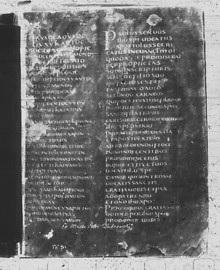 W
WCodex Sangermanensis designated by Dabs1 or 0319, α 1027 (Soden), is a tenth-century diglot manuscript, formerly in the library of St. Germain des Prés, Paris, hence its name Sangermanensis, "of Saint Germanus". It contains the Pauline Epistles, lacking most of 1 Timothy and parts of Romans and Hebrews. It is particularly notable as one of the two such copies which display clear evidence of having had Claromontanus as exemplar. It is now part of the National Library of Russia collection in Saint Petersburg.
 W
WCodex Seidelianus I, designated by siglum Ge or 011, ε 87, also known as Codex Wolfii A and Codex Harleianus is a Greek uncial manuscript of the Gospels, dated palaeographically to the 9th century. The codex contains 252 parchment leaves. The manuscript is lacunose.
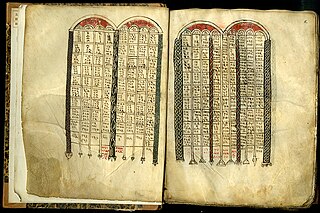 W
WCodex Tischendorfianus III – designated by siglum Λ or 039, ε 77 – is a Greek uncial manuscript of the Gospels on parchment. Palaeographically it has been assigned to the 9th or 10th century.
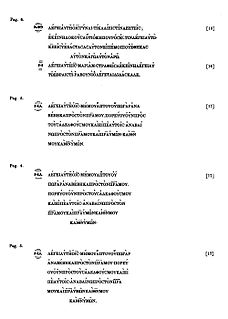 W
WUncial 050, Cι1, is a Greek uncial manuscript of the New Testament, written on parchment. Palaeographically it has been assigned to the 9th-century. Formerly it was labelled by O or We.
 W
WUncial 053 (in the Gregory-Aland numbering), A4 (Soden), is a Greek uncial manuscript of the New Testament, dated paleographically to the 9th century.
 W
WUncial 0115, ε 57 (Soden); is a Greek uncial manuscript of the New Testament, dated paleographically to the 9th or 10th-century. Formerly it was labelled by Wa.
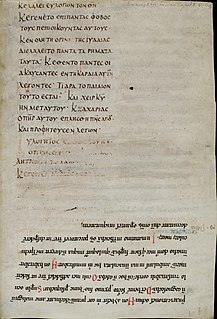 W
WUncial 0130, ε 80 (Soden), is a Greek uncial manuscript of the New Testament, dated palaeographically to the 9th-century. Formerly it was labelled by Wc.
 W
WUncial 0269, ε 83 (Soden), is a Greek uncial manuscript of the New Testament. Paleographically it has been assigned to the 9th century.
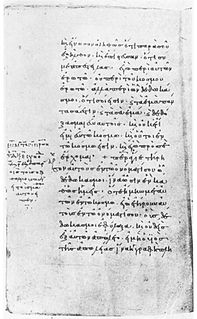 W
WThe Uspenski Gospels, Minuscule 461, ε 92 (Soden), are a New Testament minuscule manuscript written in Greek, dated at 835 AD, and now in St Petersburg in Russia. They are the oldest known dated manuscript of the New Testament; it was not customary for Greek scribes to date their work at the time.